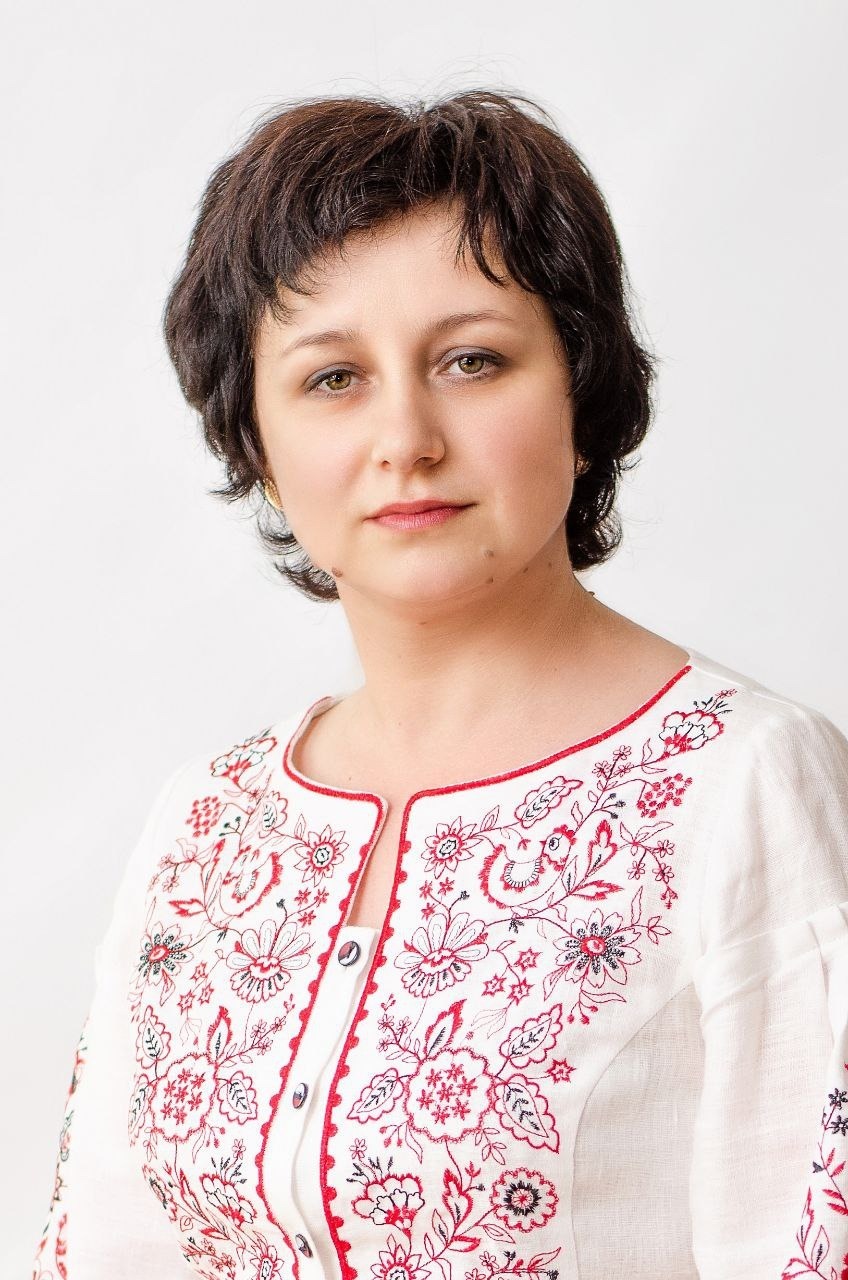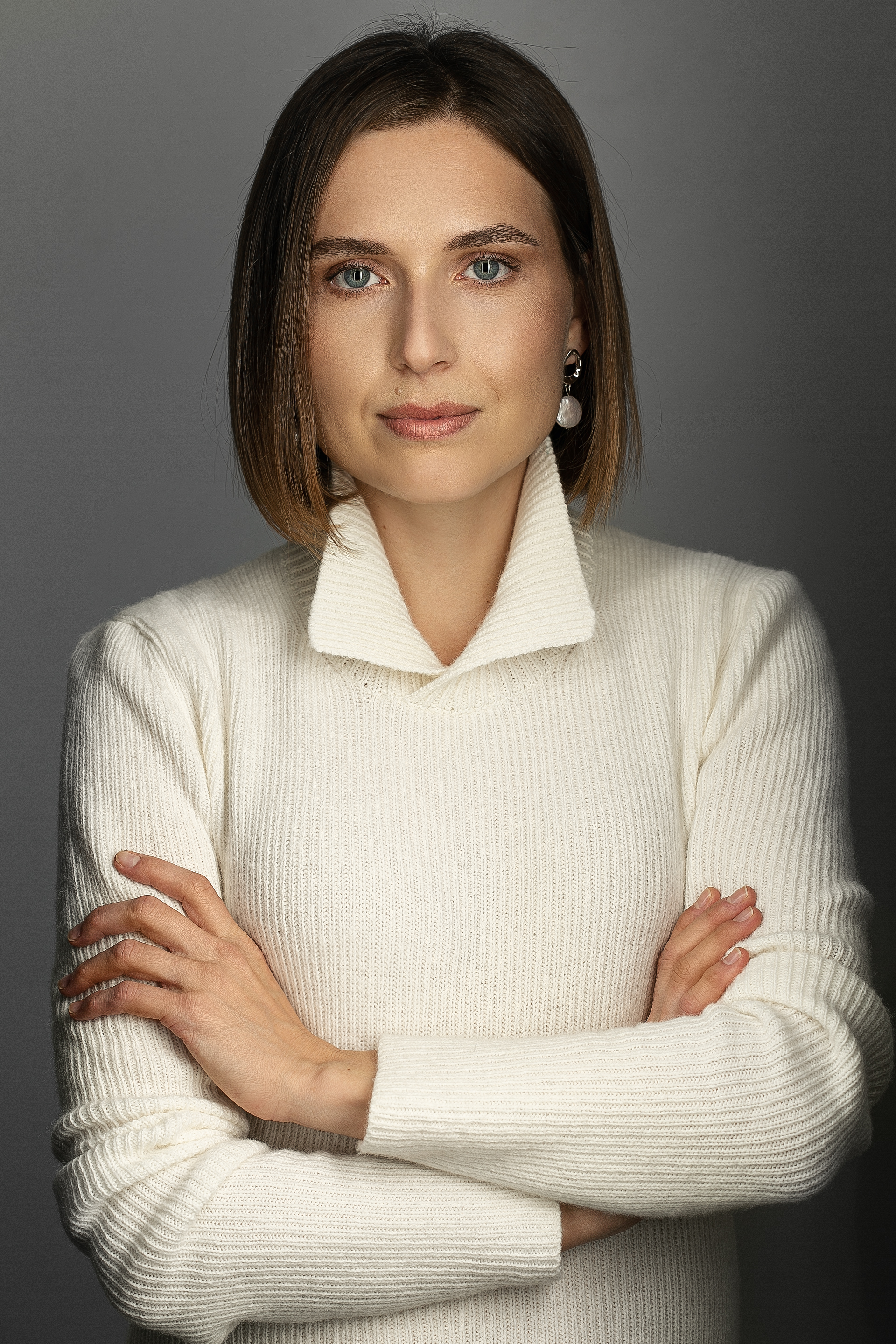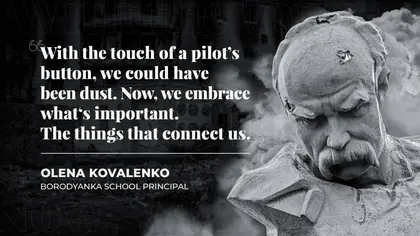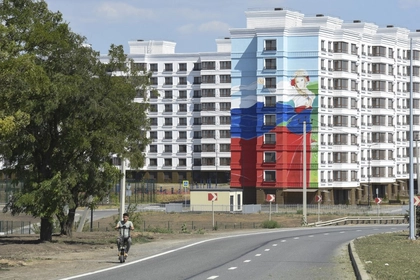Olena Kovalenko, the principal of the Borodyanka Academic Lyceum, and her IT teacher, Anatoly Avramenko, sit under a portrait of Taras Shevchenko, Ukraine’s 19th-century national poet. A block away from the school, a massive bronze bust of the beloved hero stands at the center of the town square and across the street from a fully levelled apartment building where 40 people died in the rubble. Shevchenko, the statue, bears two huge bullet holes in his forehead and temple where Russians shot hit him in March of last year.

JOIN US ON TELEGRAM
Follow our coverage of the war on the @Kyivpost_official.
Olena Kovalenko
“A little over a year ago, on Feb. 24, some of our parents first found out the invasion was occurring because they received a notice from me,” Kovalenko said. “We closed the school and we opened the shelter in our basement for some 150 people… Our school lost two students that week – an 11-year-old girl and a 12-year-old boy who died with their entire families when their bombed buildings collapsed on them. Later in the week, many of us evacuated empty-handed.”
Twelve months later, Kovalenko’s school is a sign of hope. But for the theft of 46 tablet computers, it escaped significant damage, whereas School Number 1 in another part of Borodyanka was completely destroyed. On May 1, the Lyceum re-opened its doors, following the Kyiv region’s liberation in April and the return of residents who had fled occupation.

IMF Approves $1.1 Billion Loan Disbursement to Ukraine Before Trump Inauguration
It is currently the educational home to some 900 students, which is close to its pre-war population. In-person lessons are taking place across three shifts per day for grades one to four, while students in grades five to eleven participate in on-line education for now. It has also integrated students from the destroyed School Number 1. The local city council, whose chambers were also destroyed, has temporarily moved in, too, which Kovalenko said is “good because the lights won’t go out.”
However, at this stage of the war and recovery from it, Borodyanka Academic Lyceum is more the exception than the rule, according to a new report on the destruction and rebuilding of educational infrastructure in war-torn Ukraine.
Developed by savED, an international charitable foundation that aims to support the restoration of educational access for Ukrainian communities, the report chronicles damage to schools and its impact on students and their education.
It also shares results from a survey of parents whose school-age children were affected by the disruptions and looks at school rebuilding initiatives in local communities throughout the Kyiv, Chernihiv and Kharkiv regions following their liberation.
In terms of destruction from the full-scale Russian invasion, a bleak situation is reported. As of January 2023, this includes:
· 3,051 (or 22%) of overall schools damaged by war; 420 destroyed.
· 1,259 (or 11%) of secondary schools damaged by war; 223 destroyed.
· 605,000 (or 14%) students abroad; 23,000 teachers (or 4%) abroad.
· 36% of schools teaching remotely; 36% using a mix; 28% fully back in the classroom.
· 85% of parents of school-aged children concerned about learning gaps impacting their children.
· 61% of parents concerned about mental health impacts such as insomnia, anxiety, concentration issues, and problems with communication.
“Hundreds of thousands of children have lost their schools. Our aim is to change this and to make schools safe spaces for children that they would attend willingly every morning,” savEd’s head, Anna Novosad, said.

Anna Novosad
Novosad was Ukraine’s Minister for Education and Science from 2019 to 2020, and founded savED together with GoGlobal, an NGO that has long organized international volunteers to teach English in Ukrainian schools.
“While safety and security factors are paramount for the Ukrainian refugees considering a potential return to Ukraine, access to educational services will also be among the decisive factors, especially for 87% of the refugees who are women with children,” Novosad said. “Investing in restored access to education now, and not after the long-awaited victory day, is crucial. Reconstruction of schools, provision of temporary learning spaces, and catch-up programs have to take place across all the liberated communities.”
Researchers also found school restoration is at different stages in three formerly occupied territories examined. In a hopeful sign, the report notes that as of January 2023, 59% of damaged schools (41) had been restored in the Chernihiv Region; and 71% of schools (87) which suffered damage had been restored in the Kyiv Region.
However, it further notes that “in the Kharkiv Region, hardly any rebuilding has been done and only 13 of the 296 damaged schools have been restored. This can be explained by the fact that the Kharkiv Region was liberated much later than the two other regions, that military actions and intense shelling still continue in a part of the region, and that the scale of destruction is much bigger there.”
By looking at local school rebuilding efforts, savED has developed recommended priorities for the process. It suggests a staged approach, starting with schools having adequate shelters.
It’s more than that, though, for Novosad: “We are talking about not just light rehabilitation, but capital reconstruction of schools. We have to apply a ‘build back better’ approach. Renewed schools should have a modern, inclusive and universal educational environment, as well as feature completely different approaches to the organization of the learning process. Thus, physical reconstruction has to be coupled with a soft one, such as new curriculum, training of teachers and school management.”
On the ground in Borodyanka, the main priority for Principal Kovalenko is indeed a larger bomb shelter that can take more than 200 students at a time.
“We have to run ‘live’ schooling for the younger kids in three shifts every day because we are limited in how many people fit in the bomb shelter,” she said. “Plus, parents are concerned to send their children back without that.”
Her colleague, Anatoly Avramenko agreed. His own son starts first grade at the Lyceum next September and he expressed hope that things can continue to normalize. He was visiting the school and colleagues while on leave from the Armed Forces of Ukraine, which he joined on the first day of the full-scale invasion. Avramenko lived through a missile attack on the Yavoriv military base in western Ukraine on March 13 of last year where some 35 fellow recruits were killed. He currently serves in the Donbas region. The Lyceum sends him hand warmers and socks and other useful supplies.
Kovalenko revealed that her own husband, a retired career military man, has returned to service during the invasion. They had come to Borodyanka for a more settled life some five years ago. During the invasion, she remembers standing at night on the balcony of the home they are proud of, watching fires burn in her town, and listening to her heart beat. Elsewhere, there is a “policy picture” that others develop.
The findings in savED’s report have been presented to Ukraine’s newly appointed Education and Science Minister, Oksen Lisovy. While there is currently no formal government policy with regard to school reconstruction and educational recovery at this stage, savED is hopeful that the new minister will develop one.
“It is of utmost importance that the government of Ukraine develop and roll out a national catch-up program, similar to one that the U.K. has applied (National Tutoring Program) following the Covid-19 consequences on learning loss,” Novosad said. “Moreover, vulnerable groups of kids have to be identified and helped primarily.”
Beyond its report, savED, with partners, is now “hands-on” involved in restoring educational access. It has, for example, established 16 Digital Learning Centers (DLCs) in the Kyiv and Chernihiv regions with plans to open 30 more in 2023.
The DLCs are a short-term solution to restore access where schools are substantially damaged or no longer available, such as School Number 1 where reconstruction work started in February 2023 and is scheduled for completion in November.
The DLC at Borodyanka’s Lyceum also has been used for adult education on topics such as psychological coping skills for parents. This aspect seemed important for Kovalenko, who has been forced to become knowledgeable in sourcing generators and securing electricity supply, restoring internet access, and working with international partners.
“For our kids and for our parents, I want our work to normalize. I want all our kids back here,” she said. “We’ve lived through so much. We helped each other survive and we were helped by others. As we rebuild, it’s time to remember to value those experiences and to value life. With the touch of a pilot’s button, we could have been dust. Now, we have to embrace not the materialistic, but what is most important. The things that connect us.”
You can also highlight the text and press Ctrl + Enter






